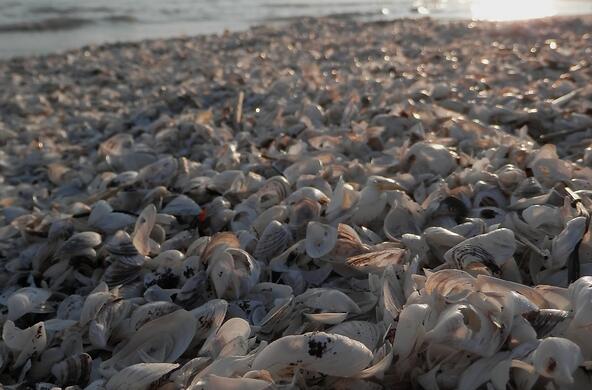The way J. Ellen Marsden remembers it, when she first suggested calling a new Great Lakes invasive species the quagga mussel, her colleague laughed, so the name stuck.
At the same time, it was no laughing matter. The arrival of a second non-native mussel, related to the already established zebra mussel, was a major complication in what was becoming one of the most significant invasive species events in American history.
“It really woke up the entire nation to aquatic invasive species,” said Marsden, who collected the first quagga mussel known in the Great Lakes system 30 years ago.
But signs of a new normal are emerging as regular surveys of dreissenid mussels in the Great Lakes reveal a changing community of invaders.
The invasive species that changed the game
When Marsden and a colleague collected the first quagga mussel in the Great Lakes system, they were studying zebra mussel genetics. They found one individual with genes that did not fit.
“That was the discovery that there were two species,” Marsden said. “It was exciting and a bit of a lurch.”
It was not immediately clear what the new species was. While zebra mussels had been invasive through much of Europe and well known by the time they reached the Great Lakes, the soon-to-be-named quagga mussel had been largely ignored since its discovery in 1897.
Scientists were not sure at that point how the mussel would affect the Great Lakes. Later, it became clear that quagga mussels would replace zebra mussels and could live much deeper than them. That meant more habitat for invasive mussels that could filter out plankton and algae, disrupting the base of the Great Lakes food chain.
While initially a local problem, the arrival of dreissenid mussels had a huge impact on the way the United States thought about aquatic invasive species.
It was the impetus for a 1996 law called the National Invasive Species Act, which established task forces across the country to prevent the spread of aquatic invasive species.
If the dreissenid invasion of the Great Lakes was spreading awareness and preparedness across the country, it was also spreading mussels.
Zebra mussels had been discovered outside the Great Lakes basin in 1991, just three years after they arrived. By 1992, they had reached the Gulf Coast via the Mississippi River, and by 2008 they were in California. Quagga mussels spread slower but no less persistently.
Both mussels can spread by hitching rides on boats and are often so small that human inspectors miss them. A quagga-sniffing dog in Washington recently identified invasive mussels human inspectors had twice missed on a boat traveling through the Columbia River basin. While the reported $60,000 price tag for training the dog might seem steep, it’s a bargain compared to the projected $300 million dollars per year an invasion could cost hydroelectric facilities in the basin. In Montana, another dreissenid-free state, the mussels could cost $234 million in mitigation efforts and lost revenue.
Despite the high stakes and immense precaution, they’re likely to continue spreading.
“We’re thinking diligence, diligence, diligence, but at some point you cannot control every boat, every angler, every kayaker,” Marsden said. “I hate to be pessimistic, but I think it’s realistic.”
30 years of change for the Great Lakes
After quagga mussels replaced zebra mussels, their populations peaked in about 2003 and declined slightly in shallow waters. They continue to increase slowly in deeper portions of the lakes, said Alexander Karatayev, director of the Great Lakes Center at Buffalo State College.
“When we’re talking about the deep Great Lakes, like Huron, Michigan and Ontario, the dreissenid population is not growing like it did,” Karatayev said.
Karatayev recently published in Journal of Great Lakes Research the results of an extensive survey of dreissenid mussels in Lake Ontario. Every five years each of the Great Lakes undergoes such a survey.
This recent report includes information on the effect of the round goby, another Great Lakes invasive species and the main predator of quagga mussels. While gobies seem to reduce quaggas of the size they most like to eat, overall they’re not impacting quagga populations in any significant way, Karatayev said.
Still, it points to ways the ecosystem is responding to the invasive mussels.
Lake sturgeon, a threatened species in the Great Lakes region, has started eating zebra and quagga mussels. It’s possible their role in removing nutrients that fuel algal blooms has aided sturgeon as well, Karatayev said.
In other areas they’ve invaded, ecosystems take on a new shape after the initial invasion.
In the Hudson River zebra mussels outweigh all native fish, insects, mollusks and other consumers combined. Every late summer, blue crabs migrate up the river and devour zebra mussels, said David Strayer, a former freshwater ecologist at the Cary Institute of Ecosystem Studies.
“Someone said it was like watching someone eat popcorn,” he said.
Where half of zebra mussels used to survive one year to the next, blue crabs have reduced that to 1% in some years, Strayer said. This has allowed some plankton—an important food source—to return to pre-invasion levels.
While the effects of the invasion have been severe—close to 1 billion pearly mussels have almost disappeared, Strayer said—it shows the native ecosystem and invasive species responding and reacting to one other.
“There’s this chain of interactions going back and forth between the ecosystem and invader,” Strayer said. “It still hasn’t settled down, the ecosystem and the mussel… I don’t know how long that’ll take.”
In the Great Lakes, slowing and declining growth in quagga mussels might hint at an emerging equilibrium, Karatayev said, but they’re not going anywhere.
“They will be big players for probably hundreds of years,” he said.






